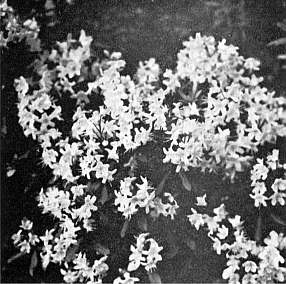QBARS - v27n3 Dwarf Rhododendrons, Book Review
Dwarf Rhododendrons
by Peter A. Cox, Batsford Ltd., London, 1973
Book Review by Jonathan Shaw, Sandwich, Mass.

|
|
FIG.40.
R. hanceanum nanum
a good
rock garden plant with pale yellow flowers for half shade. Photo by Cecil Smith |
This excellent book should be on the shelf of every rhododendron enthusiast. It is a comprehensive manual describing the appearance and cultivation of every appropriate species and hybrid and is absolutely up-to-date. The disastrous West Coast freeze of December, 1972, is mentioned, though briefly.) Included in the 296 pages are 6 drawings in color, 31 line drawings, and 46 black and white photographs.
The author, Peter Cox, is a second generation rhododendron authority and co-owner of Glendoick Gardens, an internationally known Scottish nursery, specializing in dwarf rhododendrons. Cox is a hybridist as well and is best known as the originator of 'Chikor', a dwarf yellow hybrid which was recently given a F.C.C. by the Royal Horticultural Society. He has also led several plant hunting expeditions in search of new rhododendrons and better forms of well-known species.
Potential readers should not imagine from the title that Dwarf Rhododendrons is only devoted to rock garden rhododendrons. For Cox, a dwarf rhododendron is one which matures at a height of 5 feet or under, in Mr. Cox's own garden. As he admits, readers may find that certain rhododendrons will grow taller in their own gardens.
Unlike the authors of many British gardening books, Cox has obviously consulted authorities on both sides of the Atlantic and made use of American and British experience in growing rhododendrons. American ratings (where they are available, and we seem to have somewhat neglected dwarfs) are given. The East Coast of the U.S., a difficult region because of hardiness problems, is not neglected; the section on R. keiskei , for example, refers to Guy Nearing's work in raising hardier forms and hybrids of this yellow species.
Cox discusses the distribution and ecology of the species in nature, the use of dwarfs in the garden, the varied climates where ever-optimistic enthusiasts try to grow them, and planting and maintenance. The bulk of the book is taken up with a description of the species, including a particularly interesting section on the Malesian species. Further chapters are on the hybrids (lepidote and elepidote), Obtusum azaleas, hybridization, propagation, and diseases and pests. The chapter on hybridization is particularly good and Cox has many ideas, drawn especially from his own experience, to offer would-be hybridizers.
The book has been well-edited, but I do object to the climate table on page 46 (British edition). The lay-out is confusing, low-temperature data is lacking (but surely available) from several cities and why on earth should we be informed that Cleveland is in Ohio and not learn that Boston is in Massachusetts? In addition, half the table is subdivided by continents and the other half by countries, which is untidy if not illogical. One further point may bother readers. In the species lists, the dash before the American hardiness ratings is meant to be read as a minus; a bracket might have made this clearer.
One should also add for enthusiasts on the East Coast that the American hardiness ratings are optimistic of not actually wrong in most cases. In my own garden on Cape Cod I have lost R. keleticum , though temperatures have never dropped to -10° F. for which it is rated. The fault, if there is one, is not Cox's; the hardiness ratings in his book were developed by our own Society.
All in all, one must agree with Lord Aberconway, who wrote the introduction to the British edition, that knowledgeable enthusiasts have a lot to learn from this book and that those who have yet to savor the delights of growing dwarf rhododendrons have a treat in store.
